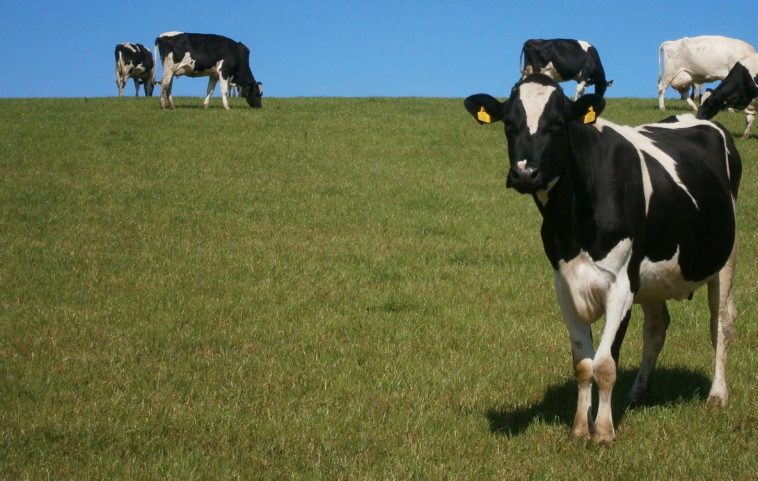High temperatures
Warm and humid weather conditions cause heat stress in dairy cows, which decreases milk production, milk quality and reproduction. The health status of the udder is also adversely influenced with a comparative increase of the somatic cell count (SCC) of the milk (Du Preez, 1999).
In Southern Africa, cows suffer from heat stress between November and March each year, when day temperatures are higher than 27°C (Groenewald, 1998).
Cattle try to keep their body temperature constant at approximately 28,5°C. During heat stress, the dairy cow cannot get rid of the heat that her body generates efficiently. There is a great need for heat loss in the cow, but environmental conditions hamper and impede the heat loss. The body temperature of cows experiencing heat stress increases from 38,5°C or sometimes to 40°C. This 1 to 1,5°C increase in a cow’s body temperature has many adverse consequences.
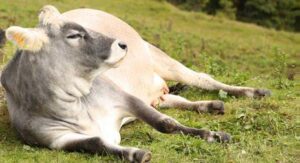
A cow’s udder is very sensitive to heat.
Determining heat stress
Heat stress is determined by calculating the temperature humidity index (THI).
Temperature, relative moisture, radiance, height above sea level and wind play a role in heat stress. The THI is used to predict the influence or effect of heat stress on a dairy cow. If the THI-value is below 70, the cow is reasonably comfortable. Her milk production is not actually affected, but her conception tempo decreases.
If humans sense an intolerance to a temperature which is unpleasant, it must be accepted that for practical purposes, dairy cows also experience heat stress.
It is a practical means of determining whether dairy cows are experiencing heat stress.
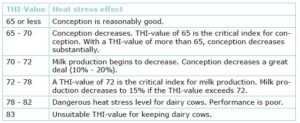
Table 1 shows the effect of different heat stress values on the cow’s performance.
Heat stress can also be determined with the THI-values.
The dew point temperature is calculated by subtracting the wet bulb temperature at 14:00 from the dry bulb temperature at 14:00. This result is now used in the psychometric tables of the weather bureau, according to the correct atmospheric pressure for determining the dew point temperature.
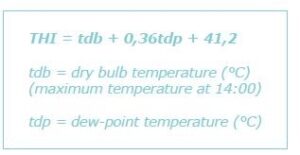
THI-values
Milk production
Research has shown that milk production decreases at high temperatures.
The environmental temperature by which milk production decreases, depends on the following factors:
- Measure of adaptability the cow Possesses
- Milk production level
- Stage of gestation
- Environmental conditions
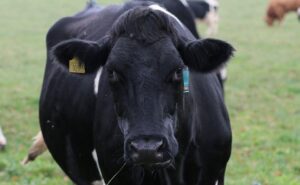
The environmental temperature at which milk production decreases, depends on the stage of gestation. (Photo by Kevsphotos, Pixabay)
Fuquay, according to Engelbrecht (1991), alleges that 24°C is the critical temperature by which milk production is decreased. Gillespie, according to Engelbrecht (1991), alleges that the decrease in milk production is approximately 10% at 27°C, while it can be 35% at 32°C. Berman, Amir and Volcani, according to Engelbrecht (1991), allege that the daily milk production of cows decreased by 6,5% at environmental temperatures of 23°C to 18°C, in comparison with cooler conditions (16°C to 22°C). McDowell, according to Engelbrecht (1991), showed that Holstein cows experienced a decrease of 14,6% in milk production during temperature increases of 18°C to 30°C.
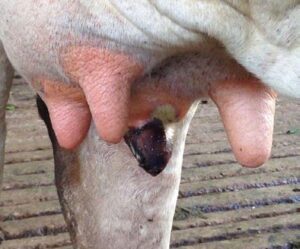
A higher measure of mastitis occurs in cows suffering from heat stress.
(Photo courtesy of vetrecordcasereports.bmj.com)
Milk composition
The total butterfat production of dairy cows decrease at environmental temperatures above 27°C. High environmental temperatures have a clearer influence on the fat-free solid content of milk than on butterfat. With temperature increases to above 29,5°C, the butterfat percentage increases as a result of the decrease in milk production. This increase in butterfat percentage correlates with the increase in butterfat percentage, which takes place during the last two to three months of lactation.
Heat stress has the following adverse effects on reproduction:
- External signs of heat in cows, such as a swollen vulva, the severe bull-string and the typical heat behaviour is suppressed and the farmer and his workers therefore do not notice it easily.
- Cows who suffer from heat stress come on heat for shorter periods, sometimes for only four to eight hours instead of 16 hours. They are also rather inclined to come on heat during the night than in the warmth of the day. This hinders heat observation.
- The period between heat periods lengthens – instead of 21 days it is 25 to 28 days.
- Conception drops. If heat stress (THI-value) is over 65, conception in dairy cows begins to drop noticeably (with 5% to 40%).
- Where two artificial inseminations (AI) were normally necessary for conception, four AI’s are necessary for covering the cows that suffer from heat stress.
- Embryo-reabsorption increases. Cows are often certified as gestating (six to ten weeks), but as a result of heat stress, she absorbs the embryo.
- The gestation period sometimes reduces with two weeks. Calves born too soon have a lower birth weight and weaker resistance mechanism. These calves are prone to diarrhoea and disease.
Udder condition
Research has shown that a higher measure of mastitis occurs in cows suffering from heat stress. Heat stress impairs the resistance mechanism of the udder, because it suppresses the ability of the white blood cells to kill germs. The somatic blood cell-count in the milk therefore increases and the milk production decreases.
Low temperatures
Decreases in milk production in ad lib fed cows in laboratory tests, only occurred with a decrease in room temperature below 12°C. It must however be kept in mind that, in this study, only the influence of cold stress was measured, while the effect of rain and wind, together with low temperatures, were not taken into account. As a result of the cooling effect of rain and wind, milk production can begin to decrease at much higher air temperatures than those found in laboratory studies. Increased fodder intake, which accompanies cold weather, will initially limit the decrease in milk production. It results however in a decrease in milk production efficiency (kg fodder/kg milk).
Published with acknowledgement to the ARC Agricultural Engineering for the use of their manuals. Visit www.arc.agric.za for more information.

